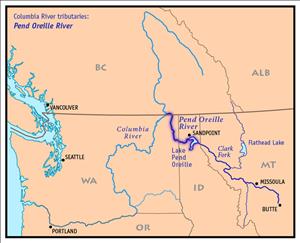From September 27 through October 6, 1809, Canadian explorer David Thompson (1770-1857) scouts the Pend Oreille River from Lake Pend Oreille in Idaho, downstream through what is now Pend Oreille County in the northeastern corner of Washington. He and the French Canadian voyageur accompanying him are the first non-Indians to reach the area. Thompson, a trader, surveyor, and mapmaker for the North West Company, is exploring the tributaries of the upper Columbia River for sources of beaver and other furs and for routes to get those furs to market.
David Thompson
Thompson, born in London in 1770, spent years roaming the rivers, lakes, and forests of central Canada from Hudson’s Bay to the foothills of the Rockies, working first for the Hudson's Bay Company and then for its rival the North West Company. Thompson’s mastery of the arcane astronomical and mathematical skills necessary to calculate longitude and latitude and draw accurate maps, combined with his years of experience with the languages and customs of the Indian peoples who supplied the furs, were invaluable to his employers.
In 1807, Thompson expanded the North West Company’s fur trading efforts across the Canadian Rockies. In 1808, he explored the Kootenai River through what is now British Columbia, Idaho, and Montana. In the late summer of 1809, Thompson led a North West Company party down a major Indian road that he called the "Great Road of the Flat Heads" (Nisbet, 144) from the Kootenai to Lake Pend Oreille in the Idaho panhandle, some 20 miles east of the present Washington-Idaho border.
Down the Pend Oreille River
Thompson and his men spent several weeks on the lake setting up a new trading post that they called Kullyspel House, their spelling of the local people’s name for themselves (now spelled Kalispel). On September 27, 1809, Thompson set off with one employee (a voyageur named Beaulieu) and a Kalispel boy, to explore the river flowing west out of Lake Pend Oreille, which he called the Saleesh River and which is now known as the Pend Oreille. Thompson hoped the river would provide a route to the Columbia, on which he could travel to the Pacific Ocean. The party traveled rapidly on horses along the Pend Oreille River, soon passing what is now the Washington border and following the river as it turned north through fine woodlands before reaching a wide marshy area near the present site of Cusick in Pend Oreille County.
There on September 30, 1809, Thompson met a party of Kalispel Indians who had had so little contact with white society that they had no iron tools. They were friendly and helpful, presenting Thompson and his companions with bread, roots, and salmon, along with information about the route downstream. In return he gave them tobacco, flint, and steel.
Since the road was not good for horses, the Kalispels provided Thompson with a somewhat leaky canoe and a guide. The party canoed down the Pend Oreille for two days, which brought them to Box Canyon above Metaline Falls (now flooded by the Box Canyon Dam). At that point, on October 2, 1809, Thompson decided to turn back in order to reach a scheduled supply rendezvous. Retracing their route up the Pend Oreille, the party reached Kullyspel House on October 6, ending Thompson’s first, but not his last, exploration in the future Washington state. In 1810, Thompson returned to the Pend Oreille and traveled farther down it, but the drop at Metaline Falls prevented him from continuing on to the Columbia, still 30 miles away. The following year, he took a different route, succeeded in reaching the Columbia, and traveled to its mouth.

